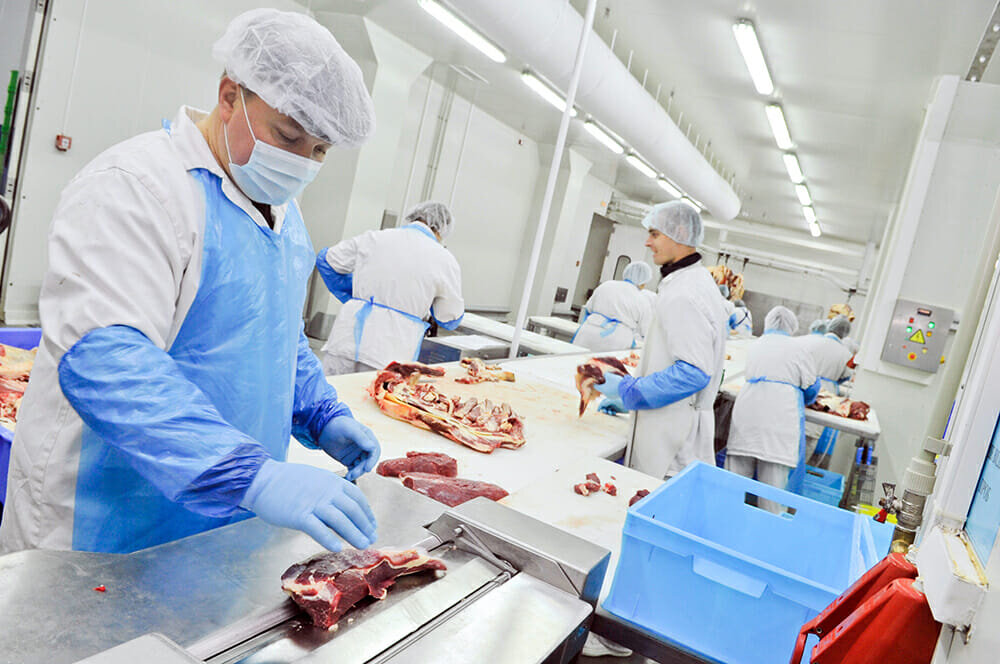Within the UK, the food and drink manufacturing sector is the largest, bigger than the automotive and aerospace sectors combined. It is no surprise therefore that around 400,000 people are employed within this essential manufacturing sector. However, this in turn highlights the reliance that the sector has historically placed on the ready availability of manual labour. Worryingly, statistics from the Food & Drink Federation predict that food and drink manufacturing businesses will need to recruit an additional 140,000 individuals by 2024 to meet the demands of a population that is fast approaching 70 million.

(Robots operating within primary and high care areas must be capable of meeting stringent hygiene standards)
Recruitment and retention of personnel is not the only issue facing the sector, another is that of productivity. Productivity is one of the key drivers in manufacturing, if you can’t make the product – you can’t sell it. In the areas where the manufacturing process is automated, save for unexpected breakdowns, productivity levels will be both high and predictable. As there are still many different areas within the food and drink sector where operators are involved, they can then become the limiting factor in productivity levels.
Recruitment forecasts such as these combined with current labour shortages, issues relating to productivity, and the various manual working restrictions imposed by the COVID Pandemic, have accelerated the interest in and demand for Robots across a wide range of food handling and processing applications.
Robots have of course been present within the food manufacturing sector for many years, initially establishing themselves in end of line packaging and palletising applications, before gradually moving upstream into faster and more demanding applications. As applications transition from tasks in secondary packaging into primary and high care operations, it is essential that the robots being used are not only capable of achieving the faster cycle rates required when handling individual products, but also capable of meeting the stringent hygiene and environmental standards required.
Given the changes which are now under way within the UK’s food manufacturing sector, it is likely that many new and future robot applications will be targeted at previously manual operations in the primary and high care areas. Not only will the demand for robots continue to increase, the focus will be on those robots designed to meeting the hygiene and environmental challenges associated with operations within high care areas.
Stäubli’s Simon Jenkins explains: ‘At first glance, the robots used in primary and high care applications may look very similar to the robots used in other sectors and applications, however there are significant differences between the two. Robots targeted at these demanding applications are specifically designed for use in sensitive and high care environments, where they can be exposed to washing and disinfecting solutions as part of a daily cleaning cycle.”
Stäubli has for many years been recognised as experts in the food processing applications, offering a range of robots with an exterior design that keeps water out, with smooth surfaces and no retention areas, positive arm pressurisation, and capable of being easily cleaned. In addition to the hygiene requirements, speed is also often a critical factor in many applications and Stäubli’s FAST picker TP80 HE has set the benchmark for performance, operating at speeds of up to 200 picks per minute.

(Stäubli’s TS2 100 HE SCARA Robots will be showcased at FOODEX by CME Limited)
Other robots within the Stäubli HE range, targeted at the food sector, include the TS2 SCARA variants, two examples of which will be showcased by Stäubli system integrator CME Limited within their meat processing system at the forthcoming FOODEX Show at the NEC Birmingham between the 5th and 7th July. CME specifically selected SCARA type robots for this system primarily due to the fact that their configuration means that, unlike Delta Type Robots, they are mounted to the side of the line and not permanently overhead. This significantly reduces the potential for dust or debris accumulating above the line and subsequently contaminating the product below. This system is targeted at manufacturers seeking to automate the picking and transfer of meat, chicken, fish, burgers and other similar products into trays as part of a fully automated packaging line.
Simon Jenkins concludes: “There has never been a better time for UK food manufacturing businesses, of all sizes, to embrace the benefits which robots and automation can bring to their production processes. Freed from the restrictions currently associated with human operators and manual processes, they can realise increased productivity, higher yields and reduced costs.”








